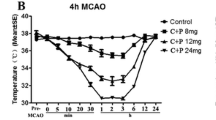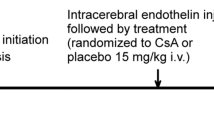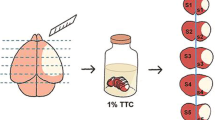Abstract
We examined whether a nitric oxide scavenger, 2-(4-carboxyphenyl)-4,4,5,5-tetramethyl-imidazoline-l-oxyl-3-oxide (carboxy-PTIO), could offer neuroprotective actions and improve cerebral energy metabolism in a model of stroke. Sixty C57BL/10J mice were given either carboxy-PTIO (0.3–1.2 mg/kg) or vehicle intraperitoneally, 0.5 h after permanent middle cerebral artery occlusion, to evaluate the dose–response effects. An additional 70 animals received carboxy-PTIO (0.6 mg/kg) or vehicle, 2–6 h post-ischemia, for establishing the therapeutic window. Subgroups of animals, treated with carboxy-PTIO (0.6 mg/kg) or vehicle, were used for measuring cerebral bioenergetic metabolites (ATP, ADP, AMP, adenosine). Mice treated with carboxy-PTIO (0.6 mg/kg) had dose-specifically reduced brain infarction, significantly by 27–30% (P < 0.05), even when therapy was delayed up to 4 h after the ischemic insult (P < 0.05). Four hour post-ischemia, ATP depleted in the ischemic hemisphere (P < 0.05). Administration with carboxy-PTIO not only improved the recovery of ATP in the ischemic hemisphere (P < 0.05), but also enhanced adenosine content across the ischemic and non-ischemic hemispheres (P < 0.05). The neuroprotection of carboxy-PTIO may be partly attributed to the beneficial effects of improving cerebral energy metabolism.







Similar content being viewed by others

References
Brown GC, Borutaite V (2001) Nitric oxide, mitochondria, and cell death. IUBMB Life 52:189–195. doi:10.1080/15216540152845993
Moncada S, Erusalimsky JD (2002) Does nitric oxide modulate mitochondrial energy generation and apoptosis? Nat Rev Mol Cell Biol 3:214–220. doi:10.1038/nrm762
Radi R, Cassina A, Hodara R (2002) Nitric oxide and peroxynitrite interactions with mitochondria. Biol Chem 383:401–409. doi:10.1515/BC.2002.044
Yabuki M, Inai Y, Yoshioka T et al (1997) Oxygen-dependent fragmentation of cellular DNA by nitric oxide. Free Radic Res 26:245–255. doi:10.3109/10715769709097803
Stewart VC, Heslegrave AJ, Brown GC et al (2002) Nitric oxide-dependent damage to neuronal mitochondria involves the NMDA receptor. Eur J Neurosci 15:458–464. doi:10.1046/j.0953-816x.2001.01878.x
Royland JE, Delfani K, Langston JW et al (1999) 7-Nitroindazole prevents 1-methyl-4-phenyl-1,2,3,6-tetrahydropyridine-induced ATP loss in the mouse striatum. Brain Res 839:41–48. doi:10.1016/S0006-8993(99)01689-3
Lee EJ, Chen HY, Wu TS et al (2002) Acute administration of Ginkgo biloba extract (EGb 761) affords neuroprotection against permanent and transient focal cerebral ischemia in Sprague–Dawley rats. J Neurosci Res 68:636–645. doi:10.1002/jnr.10251
Law A, Gauthier S, Quirion R (2001) Neuroprotective and neurorescuing effects of isoform-specific nitric oxide synthase inhibitors, nitric oxide scavenger, and antioxidant against beta-amyloid toxicity. Br J Pharmacol 133:1114–1124. doi:10.1038/sj.bjp.0704179
Hooper DC, Bagasra O, Marini JC et al (1997) Prevention of experimental allergic encephalomyelitis by targeting nitric oxide and peroxynitrite: implications for the treatment of multiple sclerosis. Proc Natl Acad Sci USA 94:2528–2533. doi:10.1073/pnas.94.6.2528
Yoshida M, Akaike T, Wada Y et al (1994) Therapeutic effects of imidazolineoxyl N-oxide against endotoxin shock through its direct nitric oxide-scavenging activity. Biochem Biophys Res Commun 202:923–930. doi:10.1006/bbrc.1994.2018
Moncada S, Higgs A (1993) The l-arginine-nitric oxide pathway. N Engl J Med 329:2002–2012. doi:10.1056/NEJM199312303292706
Araki T, Mizutani H, Matsubara M et al (2001) Nitric oxide synthase inhibitors cause motor deficits in mice. Eur Neuropsychopharmacol 11:125–133. doi:10.1016/S0924-977X(01)00077-3
Kaneda K, Yoshioka Y, Makita K et al (1997) Effects of carboxy-PTIO on systemic hemodynamics, liver energetics, and concentration of liver metabolites during endotoxic shock in rabbits: a 31P and 1H magnetic resonance spectroscopic study. Crit Care Med 25:1019–1029. doi:10.1097/00003246-199706000-00020
Tsunoda R, Okumura K, Ishizaka H et al (1994) Vasodilator effect of carboxy-2-phenyl-4,4,5,5-tetramethylimidazoline-l-oxyl in the coronary circulation: in vivo and in vitro studies. Eur J Pharmacol 262:55–63. doi:10.1016/0014-2999(94)90028-0
Shimizu S, Ishii M, Iwasaki M et al (2001) Carboxy-PTIO increases the tetrahydrobiopterin level in mouse brain microvascular endothelial cells. Jpn J Pharmacol 87:51–60. doi:10.1254/jjp.87.51
Fang SY, Tseng CC, Yang YL et al (2006) Nitric oxide scavenger carboxy-PTIO reduces infarct volume following permanent focal ischemia. Acta Anaesthesiol Taiwan 44:141–146
Connolly ES Jr, Winfree CJ, Stern DM et al (1996) Procedural and strain-related variables significantly affect outcome in a murine model of focal cerebral ischemia. Neurosurgery 38:523–532. doi:10.1097/00006123-199603000-00021
Lee EJ, Lee MY, Chen HY et al (2005) Melatonin attenuates gray and white matter damage in a mouse model of transient focal cerebral ischemia. J Pineal Res 38:42–52. doi:10.1111/j.1600-079X.2004.00173.x
Lee EJ, Chen HY, Lee MY et al (2005) Cinnamophilin reduces oxidative damage and protects against transient focal cerebral ischemia in mice. Free Radic Biol Med 39:495–510. doi:10.1016/j.freeradbiomed.2005.04.004
Chen TY, Lee MY, Chen HY et al (2006) Melatonin attenuates the postischemic increase in blood-brain barrier permeability and decreases hemorrhagic transformation of tissue-plasminogen activator therapy following ischemic stroke in mice. J Pineal Res 40:242–250. doi:10.1111/j.1600-079X.2005.00307.x
Lee EJ, Wu TS, Chang GL et al (2006) Delayed treatment with nicotinamide inhibits brain energy depletion, improves cerebral microperfusion, reduces brain infarct volume, but does not alter neurobehavioral outcome following permanent focal cerebral ischemia in Sprague Dawley rats. Curr Neurovasc Res 3:203–213. doi:10.2174/156720206778018749
Lee EJ, Wu TS, Lwee MY et al (2004) Delayed treatment with melatonin enhances electrophysiological recovery following transient focal cerebral ischemia in rats. J Pineal Res 36:33–42. doi:10.1046/j.1600-079X.2003.00093.x
Lee EJ, Lee MY, Chang GL et al (2005) Delayed treatment with magnesium: reduction of brain infarction and improvement of electrophysiological recovery following transient focal cerebral ischemia in rats. J Neurosurg 102:1085–1093
Bederson JB, Pitts LH, Germano SM et al (1986) Evaluation of 2,3,5-triphenyltetrazolium chloride as a stain for detection and quantification of experimental cerebral infarction in rats. Stroke 17:1304–1308
Lust WD, Feussner GK, Barbehenn EK et al (1981) The enzymatic measurement of adenine nucleotides and P-creatine in picomole amounts. Anal Biochem 110:258–266. doi:10.1016/0003-2697(81)90144-5
Folbergrova J, Zhao Q, Katsura K et al (1995) N-tert-butyl-alpha-phenylnitrone improves recovery of brain energy state in rats following transient focal ischemia. Proc Natl Acad Sci USA 92:5057–5061. doi:10.1073/pnas.92.11.5057
Maessen JG, van der Vusse GJ, Vork M et al (1988) Nucleotides, nucleosides, and oxypurines in human kidneys measured by use of reversed-phase high-performance liquid chromatography. Clin Chem 34:1087–1090
Bredt DS, Snyder SH (1990) Isolation of nitric oxide synthetase, a calmodulin-requiring enzyme. Proc Natl Acad Sci USA 87:682–685. doi:10.1073/pnas.87.2.682
Yoshida T, Waeber C, Huang Z et al (1995) Induction of nitric oxide synthase activity in rodent brain following middle cerebral artery occlusion. Neurosci Lett 194:214–218. doi:10.1016/0304-3940(95)11752-I
Yu WJ, Juang SW, Chin WT et al (2000) Insulin restores neuronal nitric oxide synthase expression in streptozotocin-induced diabetic rats. Life Sci 68:625–634. doi:10.1016/S0024-3205(00)00967-X
Belayev L, Alonso OF, Busto R et al (1996) Middle cerebral artery occlusion in the rat by intraluminal suture. Neurological and pathological evaluation of an improved model. Stroke 27:1616–1623
Sequeira SM, Ambrosio AF, Malva JO et al (1997) Modulation of glutamate release from rat hippocampal synaptosomes by nitric oxide. Nitric Oxide 1:315–329. doi:10.1006/niox.1997.0144
Obata T, Sato T, Yamanaka Y et al (1998) NO and cGMP facilitate adenosine production in rat hearts via activation of ecto-5′-nucleotidase. Pflugers Arch 436:984–990. doi:10.1007/s004240050733
Winn HR, Park TS, Curnish RR et al (1980) Incorporation of adenosine and its metabolites into brain nucleotides. Am J Physiol 239:H212–H219
Jung KH, Chu K, Ko SY et al (2006) Early intravenous infusion of sodium nitrite protects brain against in vivo ischemia-reperfusion injury. Stroke 37:2744–2750. doi:10.1161/01.STR.0000245116.40163.1c
Hata R, Maeda K, Hermann D et al (2000) Dynamics of regional brain metabolism and gene expression after middle cerebral artery occlusion in mice. J Cereb Blood Flow Metab 20:306–315. doi:10.1097/00004647-200002000-00012
Hatfield RH, Gill R, Brazell C (1992) The dose–response relationship and therapeutic window for dizocilpine (MK-801) in a rat focal ischaemia model. Eur J Pharmacol 216:1–7. doi:10.1016/0014-2999(92)90201-E
Ren JM, Finklestein SP (1997) Time window of infarct reduction by intravenous basic fibroblast growth factor in focal cerebral ischemia. Eur J Pharmacol 327:11–16. doi:10.1016/S0014-2999(97)89672-0
Markgraf CG, Velayo NL, Johnson MP et al (1998) Six-hour window of opportunity for calpain inhibition in focal cerebral ischemia in rats. Stroke 29:152–158
Cao X, Phillis JW (1994) Alpha-Phenyl-tert-butyl-nitrone reduces cortical infarct and edema in rats subjected to focal ischemia. Brain Res 644:267–272. doi:10.1016/0006-8993(94)91689-6
Acknowledgments
This research was supported by grants from the National Cheng Kung University Hospital (NCKUH 90-039 & 91-014) and the National Science Council of Taiwan (NSC 90-2314-B-006-157 & 90-2314-B-006-160).
Author information
Authors and Affiliations
Corresponding author
Rights and permissions
About this article
Cite this article
Lee, EJ., Hung, YC., Chen, HY. et al. Delayed Treatment with Carboxy-PTIO Permits a 4-h Therapeutic Window of Opportunity and Prevents Against Ischemia-Induced Energy Depletion Following Permanent Focal Cerebral Ischemia in Mice. Neurochem Res 34, 1157–1166 (2009). https://doi.org/10.1007/s11064-008-9892-5
Accepted:
Published:
Issue Date:
DOI: https://doi.org/10.1007/s11064-008-9892-5



